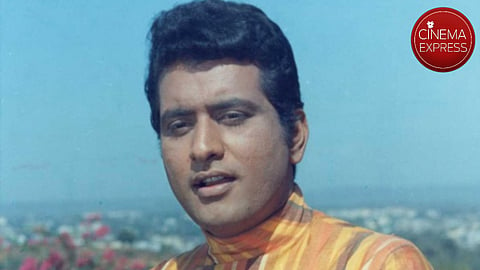

As school students, when veteran actor Manoj Kumar’s song ‘Bharat Ka Rehnewala Hoon’, started crackling from the rusty speakers, it was our cue that the Independence Day celebrations were in their final act. I remember different versions of the same image. School kids dressed as Hindu priests, Imams, farmers, doctors, engineers, stereotypically pan-chewing, dhoti-wearing Bengalis, South Indians with foreheads white with chalk because sandalwood might have not been available so early in the morning, all waving the tri-colour, praising the open-hearted acceptance of India and Indians. “Hain preet jaha ki reet sada (Where love has always been the tradition)”. This visual was so etched in my memory that when I ultimately watched the actor lip-sync to this introduction to India inside Bollywood’s version of a UK club with rotating dinner tables in Purab Aur Pachhim (1970), it just didn’t fit. Who is this guy?
Actor-filmmaker Manoj Kumar, whose name became synonymous with cinematic patriotism in post-independence India, passed away in Mumbai on Friday. He was 87. He was suffering from age-related ailments, including complications in his heart and liver. His son, Kunal Goswami confirmed the news. “It's the grace of God that he bid adieu to this world peacefully,” he told ANI.
In a way, Kumar’s story is a story of two names. One he gave to himself, and the other the world gave to him. Born Harikrishan Giri Goswami on July 14, 1937, in Abbottabad in undivided British India, Kumar, along with his family, migrated to Delhi during the Partition. In an interview with BBC Hindi, he spoke about why he named himself Manoj Kumar. “When we were living in a refugee camp in Delhi, I saw Dilip Kumar’s Shabnam (1949),” he said. “His character was named Manoj in the film. I liked it. Our camp was filled with people who spoke different languages, but nobody was named Manoj. I decided to name myself that when I become an actor.”
He earned his second moniker, ‘Bharat', in accordance with his character’s name in nationalistic films he acted in and directed, like Upkar (1967), Purab Aur Pachhim (1970), Roti Kapda Aur Makaan (1974) and Kranti (1981). The seed for what later became his brand of patriotic cinema was sown in the 1965 film Shaheed, directed by S Ram Sharma, where he essayed the role of Bhagat Singh. In an interview, Kumar recollected a childhood incident which made him adamant to play the late freedom fighter one day. “When I was a child, I was given the role of Bhagat Singh in a street play,” he said. “I got cold feet before the performance and couldn’t go ahead with it. My father even ridiculed me and said, ‘You couldn’t even become a fake Bhagat Singh.’ I took it to heart.” When the film released, it won a National Award, and Kumar donated the entire prize money to the late freedom fighter’s family.
Kumar can be called the pioneer of the patriotic film, although of a less virulent version that is prevalent today. His directorial debut, Upkar, saw him in the role of a farmer-turned-soldier who also reforms his selfish, westernised brother, played by Prem Chopra. With the preachy yet influential Purab Aur Pachhim, Kumar tried to speak to Indians living abroad, urging them to embrace their cultural identity rather than conforming to a foreign mould. The film later inspired Akshay Kumar’s 2007 romantic comedy Namastey London. While Kumar’s films were often melodramatic—a hallmark of that era—they were never malicious.
The actor’s filmography, however, can’t be just reduced to nationalistic cinema. Two mystery thrillers, acclaimed Hindi noir director Raj Khosla’s Woh Kaun Thi? (1964) and Raja Nawathe’s Gumnaam (1965), inspired by Agatha Christie’s seminal novel And Then There Were None, stand out. I still remember being haunted by Lata Mangeshkar’s melisma in the song ‘Naina Barse’ from Woh Kaun Thi? and how a perplexed Kumar wandered through the snowy vastness of a valley, searching for a mysterious woman in white.
The actor was often criticised for trying to imitate his idol Dilip Kumar’s acting mannerisms. He sometimes mumbled dialogues while keeping his hand on his face in a strange way, and this style invited many parodies. Kumar got the opportunity to share screen space with the tragedy king in Aadmi (1968) and later Kranti (1981), in which he also got to direct his idol. The anecdote, in which Kumar talked about why he named himself Manoj, begins on a sweet note of a child being curious about the finiteness of life. “I saw a film in which Dilip Kumar dies,” Kumar said in an interview. “Later, I saw another film of his, Shaheed (1948), where he dies again. I was disturbed. I asked my mother, ‘How many times can a man die?’ She replied, ‘Just once.’ ‘But what about those who do more than once?’ ‘They can only be angels,’ she answered. I thought to myself, One day I will also become an angel.”